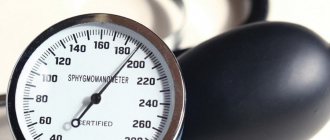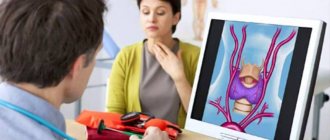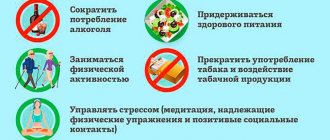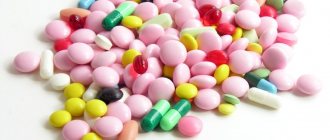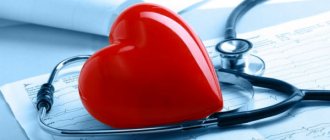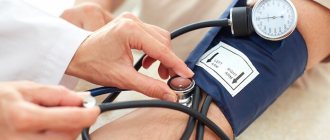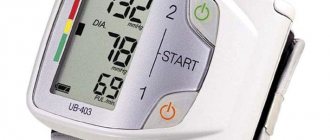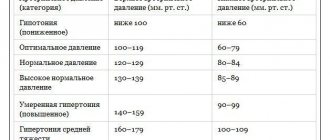In medical practice, pressure refers to the force with which blood exerts pressure on the walls of the blood supplying structures. In particular, arteries, which is why they most often talk about blood pressure.
Veins and capillaries are considered somewhat less frequently. Pressure is a generally accepted indicator of the health of the cardiovascular system; the state of blood supply to tissues and organs (partially) depends on it.
The normal indicator at the global level is not a specific figure, but a range from 100 to 140 by 60-90. Anything higher is hypertension with characteristic symptoms.
Interesting:
There is a concept of “working” blood pressure, but in this case it is not applicable: the level of “working” blood pressure can vary by no more than 10 mmHg from the norm.
Pressure 160 to 120 mmHg. Art. indicates a pathological process. What kind exactly - the doctor finds out. Self-diagnosis will not give anything.
High blood pressure levels pose a much greater health risk than low blood pressure in the short and long term: strokes, heart attacks, etc. are likely to develop soon.
Reasons for a one-time increase in blood pressure
There are not many reasons why blood pressure can “jump” sharply; there are many more pathological conditions with a persistent or regular increase in tonometer numbers. Nevertheless, such factors exist.
What are they:
- Abuse of coffee, strong tea, tonic drinks. Caffeine causes stenosis (narrowing) of large blood vessels at all levels, disrupting normal blood flow. Hematological fluid has to overcome significant resistance from the walls of the blood supplying structures. Hence the increase in blood pressure.
- Stress. Always accompanied by the release of a huge amount of corticosteroids (hormones of the adrenal cortex): norepinephrine, adrenaline and cortisol.
Individually, they have pronounced hypertensive properties. Together they give an even greater pathological effect. This is necessary to mobilize the body for an imaginary fight against unfavorable external factors.
The natural defense mechanism inherited from our ancestors can play a cruel joke.
- Alcohol abuse. Contrary to popular belief, alcohol does not have a positive effect on blood vessels.
In the initial phase of metabolism, they actually expand: the person turns red, and there is an active flow of blood to the tissues.
Already after 20-30 minutes, or even earlier, the reverse process is observed: narrowing of the lumen of blood vessels, an increase in blood pressure and temperature.
A weakened body may not be able to withstand such an overload. Conclusion: alcohol is the enemy of cardiovascular health.
- Abuse of certain medications. What drugs can increase blood pressure - Citramon, aspirin, mood stabilizers, some antipsychotics and others. Before use, it is recommended that, firstly, read the annotation, and secondly, consult a doctor about possible adverse events.
- Consuming large amounts of table salt the day before. Salt is crystallized sodium chloride. Sodium compounds retain fluid in the body, preventing it from being removed. This is a path to hemodynamic disturbances and increased blood pressure levels, sometimes to significant levels.
- Drinking large amounts of fluid is associated with an increased load on the entire cardiovascular system.
As already noted, pathogenic factors in the development of hypertension are much more common.
Why is constantly elevated blood pressure dangerous?
Chronic hypertension leads to the development of a heart attack.
If an adult’s blood pressure rises to 160/80 once, and there are no other health problems, it is enough to exclude provoking factors - stress, lack of sleep, overwork, and the condition will normalize without special treatment. Chronic hypertension, in which high blood pressure is constantly observed, leads to the development of the following negative consequences:
- acute myocardial and renal failure;
- ischemia;
- heart attack;
- stroke;
- persistent increase in heart rate;
- arrhythmia.
Endocrine system disorders
This is a large layer of diseases. Key and frequently encountered:
- Hyperthyroidism. In other words, excess production of thyroid hormones (active substances of the thyroid gland). The thyroid gland is a kind of cauldron of the human body.
With excessive work, activation of all organs and systems is observed, the body mobilizes and burns resources. This is a dangerous process: the body works for wear and tear.
Blood pressure of 160 to 120 may be constant and not subside on its own. There is a high temperature, general malaise, and external signs of the disease are evident. Causes: thyroid neoplasms or the development of diffuse goiter.
- Tumors or injuries of the pituitary gland. In both cases, there is excess production of corticotropin. This active substance is synthesized by the anterior pituitary gland and stimulates the adrenal glands to produce more cortisol.
With hormonally active tumors of the brain localization, large non-secreting tumors, excessive synthesis of the substance occurs. The result is the development of secondary Itsenko-Cushing’s disease with high blood pressure and other “delights” of this destructive pathology.
- Diseases of the adrenal glands themselves. They are also accompanied by excessive production of cortisol (a substance that increases blood pressure).
- Malignant neoplasms of the body of any localization. Characterized by systematic increases in blood pressure.
Reasons by age group
In children and adolescents, the most common factors in the development of arterial hypertension are:
- Excessive consumption of table salt. As already said. Systematic abuse of this substance leads to a persistent increase in blood pressure readings.
- Excess body weight. Provokes hemodynamic disturbances and increases the load on the heart and blood vessels. Therefore, it is recommended to monitor the child’s diet and prevent obesity in the early years of life until stable eating habits are formed.
- Physical inactivity. Modern children increasingly prefer a sedentary lifestyle at the computer. Active games are becoming a thing of the past. Hence the increased incidence of early hypertension. Blood flow is disrupted and cardiac activity is not trained. Is it dangerous.
For teenagers, the list of reasons is somewhat wider.
These factors are supplemented by:
- Temporary hormonal imbalance. Blood pressure during puberty (puberty) is unstable. It constantly jumps within wide limits. This is a temporary phenomenon, which, however, needs to be corrected if there is a danger to health and life. The issue is resolved individually with an endocrinologist and cardiologist.
- Drinking alcohol, smoking. Few people would be surprised by a teenager who smokes or drinks. Bad habits are a direct path to hypertension at an early age.
Youth, middle-aged people (up to 40 years):
Usually we are talking about somatic diseases. Thyroid gland, pituitary gland, adrenal glands. Diabetes mellitus. Variations are possible. Often a person creates a problem for himself: smokes, drinks, abuses fatty foods.
Representatives of the older age group (over 40 years old).
In this case, we are talking about the accumulated baggage of diseases and general wear and tear of the body. Among the common reasons:
- Atherosclerosis. Narrowing of the lumen of blood vessels or occlusion of arteries by cholesterol plaques. With a long ongoing process, they become calcified and exist on a permanent basis.
- Kidney pathologies. First of all, pyelonephritis. Develops in many older patients. Accompanied by an increase in blood pressure. Nephritis and glomerulonephritis also provoke an increase in tonometer readings.
An unfavorable outcome of a long course of hypertension of renal origin is the formation of so-called malignant hypertension. This is a deadly process. It does not occur with numbers of 160 to 120-124, but with much higher numbers.
In the vast majority of cases, the process occurs with mild tachycardia: 90-100 beats per minute. Over time, the patient gets used to it, but this is not normal.
Pressure for hypertension
Have you been struggling with HYPERTENSION for many years without success?
Head of the Institute: “You will be amazed at how easy it is to cure hypertension by taking it every day...
Read more "
One third of the world's population shows signs of hypertension. Pressure from hypertension causes stenosis and damage to blood vessels, and sometimes hemorrhagic infarction. Therefore, even for healthy people it is extremely important to know what pressure is, what affects it, what indicators can be considered normal, what numbers on the tonometer should serve as a signal to start treatment.
The essence of the concept
Blood pressure is determined by the force of its influence on the main and peripheral vessels. Pressure indicators are directly dependent on several factors:
- elasticity of blood vessels;
- heart rate;
- the volume of blood pumped by the heart in a certain period of time.
The value of blood pressure (BP) is usually written as a ratio in which:
- the upper number, the larger one, is the systolic pressure (during heart contraction);
- the lower number, the smaller one, is the diastolic pressure (in the interval between heartbeats).
Blood pressure can change - with a change in body position, during exercise, during nervous stress, at rest or after eating. If a person does not experience health problems, after a short time the pressure will stabilize. With hypertension, its elevated levels persist for quite a long time. Hypertensive patients experience sharp fluctuations in blood pressure. Normal after sleep, after eating it may rise, then fall. Evening pressure readings usually exceed morning ones, and at night they sometimes drop sharply.
When analyzing blood pressure readings, the top number is usually given more importance. It is increased systolic pressure that is considered to be the main risk factor for the development of cardiovascular pathologies in patients over 50 years of age. In the vast majority of people, it increases over the years - due to the fact that the main arteries lose their elasticity and are exposed to atherosclerotic plaques.
Norm and pathology
Blood pressure is an individual indicator, depending on age, environmental conditions, concomitant pathologies and even the time of day. But there are average medical indicators. Having found out what pressure the patient has, the doctor determines whether it is hypertension or a normal variant.
Blood pressure indicators in patients over 18 years of age
Pressure
Indicators, mm Hg. Art.
| Systolic | Diastolic | |
| Optimal | Less than 120 | Less than 80 |
| Normal | Up to 130 | Up to 85 |
| Normal high | Up to 140 | Up to 90 |
| 1 degree hypertension | Up to 160 | Up to 100 |
| 2nd degree hypertension | Up to 180 | Up to 110 |
| 3rd degree hypertension | Over 180 | Over 110 |
| Isolated systolic hypertension | Over 180 | Less than 110 |
Systematic blood pressure monitoring will help avoid serious consequences of hypertension, since pathological changes in indicators will be noticed in a timely manner.
Reasons for deviation from the norm
Blood pressure never changes without reason. Its fluctuations can be caused by diseases of the cardiovascular, digestive, genitourinary systems, and traumatic brain injuries. But the factors that provoke changes are not always caused by pathologies. An increase in blood pressure often occurs due to:
- allergic reactions;
- stressful situations;
- hormonal imbalances;
- smoking;
- alcohol abuse;
- weather dependence;
- taking certain medications;
- overwork;
- dehydration;
- eating fatty foods;
- excessive salt intake;
- physical inactivity or, on the contrary, physical overexertion.
Why do you feed pharmacies if hypertension is afraid of the usual like fire...
Tabakov has revealed a unique remedy against hypertension! To reduce blood pressure while preserving blood vessels, add to…
Increased blood pressure can be caused by age-related changes in the body and hereditary predisposition.
Clinical manifestations
The increased blood pressure is very noticeable. Visual symptoms of pathological changes are often:
- acute headache (usually in the temples and back of the head), often accompanied by gag reflexes;
- redness of the skin (sometimes networks of blood vessels appear);
- severe weakness, tinnitus, spots before the eyes;
- redness of the whites of the eyes (sometimes impaired visual acuity);
- dyspnea;
- chest pain;
- chills;
- insomnia;
- cardiopalmus;
- increased sweating.
If you have such symptoms, you should consult a doctor. Early hypertension is dangerous because it is asymptomatic. A person sometimes doesn’t even think about the fact that he may have high blood pressure.
With high blood pressure, it is necessary to include in the diet foods that can effectively break down fats and prevent blood clots.
Diagnosing changes
After 20 years, it is recommended to measure blood pressure during medical examinations. If it is higher than normal, the doctor prescribes additional tests. One-time high readings do not always indicate the presence of hypertension. The disease is diagnosed if elevated levels are observed during several consecutive examinations, and also if they persist after three months of following the doctor’s instructions for lifestyle adjustments.
Self-diagnosis by pulse
Without a medical device, it is impossible to accurately determine blood pressure readings, but you can assume the presence of negative changes by looking at your pulse. By placing your ring and index fingers on your wrist or carotid artery, you should count the number of heart beats in 30 seconds and multiply the resulting figure by two (the number of beats per minute). A pulse of 60-80 beats is considered normal. With elevated blood pressure, the pulse can be felt without difficulty. If you have a heart rate monitor, you can use it.
Using a blood pressure monitor
To accurately measure blood pressure, various types of tonometers are used. The designs of the device differ in the principle of operation. Mercury tonometers were replaced by pneumatic and then electronic devices. The latter can be easily used by anyone, even without a medical education. They are characterized by compactness, accuracy and ease of use.
Typically, such tonometers show not only systolic and diastolic pressure, but also pulse rate. At the same time, previous measurements are “remembered”, according to which specialists track the dynamics of changes in blood pressure in each individual patient.
Measuring rules
Blood pressure measurements must be taken with the utmost care. This applies to both specialists and patients themselves, who independently monitor their blood pressure levels. There are certain rules:
- the day before the measurement you need to give up tonic drinks and smoking;
- on the day of measurement, you should not use eye and nasal drops;
- You need to measure your blood pressure half an hour after eating;
- before applying the tonometer cuff, the patient should take a comfortable position, placing a relaxed hand on a flat, hard surface;
- The cuff should be placed in the middle of the shoulder. Its bottom edge should be 2.5 cm from the ulnar recess. The air tubes should lie along the midline of the shoulder;
- between the cuff, located at the same level as the heart, and the shoulder, you need to leave a gap into which a finger can easily fit;
- You should remain absolutely calm while the tonometer is operating.
First, experts recommend measuring pressure on both hands, then only on the one that “gives” the highest readings. If the measurement is carried out outside the walls of a medical institution, the patient is recommended to keep a “recording” notebook and enter the day, time and measurement indicators in it. The doctor determines how often measurements should be taken.
Possible consequences
High blood pressure with hypertension is fraught with hypertensive crises - sudden jumps in readings to critical levels. Such conditions provoke a sharp dilation of blood vessels, which can rupture. Some of the consequences of hypertension include:
- eye problems (decreased visual acuity, hemorrhages);
- renal failure;
- cardiac ischemia;
- heart failure;
- angina pectoris;
- stroke;
- heart attack;
- impotence;
- pulmonary and cerebral edema;
- death.
If there is a risk of aortic aneurysm detachment, it is recommended to reduce the pressure as quickly as possible. And in case of cerebral disorders, this should be done without haste, otherwise they will worsen.
High blood pressure often causes disability and even death of the patient.
Home remedies
In case of a hypertensive crisis (upper pressure above 200 mmHg), you must urgently call an ambulance and, before its arrival, begin to take measures to eliminate the symptoms. With a moderate increase in pressure, you can act independently.
Preventive action
If there are signs of increased pressure, it is necessary to measure its indicators. Headache, nausea, weakness can also occur for other reasons. If your blood pressure is really high, you should:
- ensure peace, darkness and silence (including in the workplace);
- provide access to fresh air;
- lie down with your head raised (at work, if this is not possible, sit more comfortably);
- do breathing exercises (diaphragmatic breathing, focused on exhalation);
- massage the collar area and head (it is advisable for relatives or friends to do this);
- drink a diuretic decoction (parsley, lingonberries, green or kidney tea, rose hips).
Such measures lower blood pressure slowly and are aimed more at preventing the development of complications. If they do not help, you need to contact a cardiologist.
Quick effect
Patients with an active lifestyle often encounter the problem of a rapid decrease in blood pressure. Medications can do this, but they should be used carefully to avoid overdose, too rapid reduction in blood pressure and other complications. The attending physician must prescribe medications. The following will help you lower your blood pressure quickly and safely:
- peace;
- cooling compress on the head;
- warm baths for the extremities (not hot!). You can use a container of water or a heating pad, mustard plasters;
- soothing herbal tea (valerian, motherwort, chamomile, mint, lemon balm).
In the absence of the expected effect, the listed measures are supplemented with medications.
Home first aid kit
If you regularly experience problems with blood pressure, your home first aid kit should always include:
- Corvalol;
- Corinfar;
- Obzidan;
- Nitroglycerine.
The lack of emergency medications can be compensated by using a “permanent” medication (Egilok, Kapoten, Enap), but its effect will be noticeable only an hour or two after administration. When taking pharmaceuticals, you should:
- use only products prescribed by a doctor;
- do not mix drugs;
- dissolve “emergency” tablets rather than swallow them;
- take the medicine while lying down (after taking it, remain in a horizontal position for another 30 minutes). If necessary, stand up slowly.
When taking pharmaceuticals, it is necessary to pay attention to contraindications and side effects.
Unavoidable restrictions
With high blood pressure, in order to avoid the development of negative consequences, it is necessary to adhere to certain restrictions:
- Avoid increased physical activity for 24 hours after blood pressure stabilizes;
- avoid psycho-emotional overload, and if stressful situations inevitably arise, take sedatives;
- Stop drinking alcohol, caffeinated drinks and smoking.
Fatty and overly salty foods (smoked meats, canned food, including) should be excluded from the diet. After normalizing the pressure, you should limit the amount of fluid consumed for a couple of days.
Treatment of hypertension depends on the type of high blood pressure, as well as the phase of the pathological process. It is possible to use combination and monotherapy. After a thorough diagnosis and prescription of medications, the cardiologist will give recommendations on maintaining normal blood pressure, as well as on the measures that are needed if it increases sharply.
Some reasons for blood pressure 160 to 120 in women
In addition to the above reasons, in women there are a number of relatively physiological conditions when such indicators are possible, since their hormonal levels are less stable than in men, and there are more peak conditions.
During the menstrual cycle (especially in the first and second phases), hemodynamic disturbances occur, temporary but significant and accompanied by changes in blood pressure.
Premenopause, menopause and postmenopause are always accompanied by jumps in tonometer readings, both up and down.
During pregnancy, blood pressure is usually steadily reduced. Hypertension is uncharacteristic and may indicate the presence of somatic diseases, although there are exceptions. It is necessary to check for these even at the stage of pregnancy planning.
What are the dangers of high blood pressure?
If the blood pressure has exceeded the permissible norms and is even close to the point that a hypertensive crisis may develop, then this phenomenon should not be ignored. First of all, this condition indicates that the vessels are in a critical position and have been subject to wear and tear for a long time.
With such indicators, the patient faces a sharp risk of developing a heart attack and stroke, which can lead to irreversible processes in the body. If a stroke occurs, then a hemorrhage occurs in the brain and in such a situation the small vascular plexuses cannot withstand the heavy load and a hematoma forms. Against this background, the function of the organs of vision and hearing may be impaired, as well as the central nervous system as a whole.
An equally dangerous condition is myocardial infarction. In this case, the patient experiences death of some areas of the heart muscle, followed by their replacement with connective tissue. Against this background, the number of vessels supplying the myocardium decreases, but at the same time, in turn, hypertrophied, altered muscle tissue requires more nutrients.
These two complications are possible if the patient is not provided with medical assistance in a timely manner. In such a situation, the first thing to do is to calm down and take a comfortable position. There must be a full flow of fresh air in the room where the patient is located. Before the ambulance arrives, you must take an antihypertensive or vasodilator.
Symptoms that require you to see a doctor
Among the warning signs:
- Intense pounding headache. May worsen with physical activity. Pulsates in time with the beats of the heart.
- Dizziness.
- Tachycardia (heart rate acceleration over 80 beats per minute).
- Swelling of the face and limbs in the morning.
- Cognitive impairment: decreased memory and performance, especially during the daytime.
- Increased sweating.
- Chills.
- Goosebumps before the eyes.
These are all possible symptoms of hypertension.
Blood pressure of 160 to 120 manifests itself in the same way in women and men. Representatives of the stronger sex may have an additional problem with potency.
How does a person feel?
The manifestation of grade 2 hypertension in men and women looks the same. First of all, “head” symptoms develop:
- dizziness;
- migraine;
- localization of pain in the occipital region;
- noise in ears;
- The skin of the face takes on a red tint.
The symptom of “squeezing the head in a vice” is an indicator of a hypertensive crisis. It is important that the younger the person (less than 40 years), the lower the pressure indicator leads to the development of a crisis.
So, for example, in girls 25-30 years old the indicator is 160 to 110 mmHg. Art. is a sign of a crisis that has already begun.
In addition to headache pathologies, the patient may experience:
- pulsation of the cephalic veins;
- chills;
- sweating;
- feverish condition;
- numbness of fingers and toes;
- trembling of the upper limbs;
- partial numbness of the body;
- Pain in the eyes;
- running black spots.
The occurrence of cold and increased sweating is associated with spasm of the arteries and slowing of blood supply. Sometimes patients may suffer from attacks of nausea with gag reflexes; swelling of the lower extremities and face occurs after waking up and at the end of the working day. Representatives of the fair sex experience disturbances in their menstrual cycle.
Decreased performance and chronic fatigue worsen the quality of life. An increase in blood pressure can only be confirmed by measuring it with a tonometer.
If values of 160 to 100-120 are detected frequently, then you should seek medical advice from your local physician or cardiologist.
How to help yourself at home?
There is no way to help. All the popular advice, such as washing with cold water, taking a contrast shower, or immersing your hands in hot water, is not only useless, but also dangerous.
If the pressure has risen to 160 to 120, you need to take a horizontal position, take a tablet of a prescribed emergency antihypertensive drug, or call an ambulance if there is none, or the pressure does not decrease within 30 minutes after taking the medication.
Additionally, the use of sedatives of plant origin is allowed. These are: Valocordin, Motherwort, Valerian in tablet form (not alcohol tinctures).
In the future, you should consult a doctor to prescribe or adjust therapy.
What to do with AD 160120
First aid for second-degree hypertension consists of the following steps:
- Calm the patient and help him take a semi-lying position;
- Provide access to fresh air;
- Give the patient tincture of valerian or motherwort. Excessive panic can significantly worsen the patient’s condition;
- Take an extra dose of antihypertensive drugs, if any were previously prescribed by your doctor;
- Wait for the ambulance to arrive.
Under no circumstances should you take antihypertensive drugs unless they have been prescribed by a doctor! This can lead to irreparable consequences.
Medicines prescribed by a doctor may belong to a variety of active groups:
- diuretics - Canephron, Diacarb;
- sartans - Valsartan, Losartan;
- calcium antagonists - Amlotop, Diltiazem;
- beta blockers - Bitoptik, Atenolol.
You can fight hypertension using traditional methods, which include drinking plenty of freshly squeezed rosehip, radish, pomegranate or carrot juices, since they are diuretics and help lower blood pressure.
Screening for hypertension
Diagnosis of hypertension in adults and children is the prerogative of doctors of several specialties, since the etiology of the process is different.
Specialist - cardiologist.
You may need to consult a neurologist, nephrologist, endocrinologist, neurologist (depending on the primary disease).
The list of objective studies is as follows:
- Patient interview.
- Anamnesis collection.
- Determination of heart rate.
- Measuring blood pressure on both arms.
- Daily tonometry using a special monitor.
- Ultrasound of the kidneys.
- Electrocardiography.
- Assessment of the concentration of thyroid hormones, pituitary gland, sex hormones.
- Assessment of neurological status.
As a rule, nothing more is required. In difficult cases, angiography and MRI diagnostics are indicated. Stress tests are prescribed with caution. Everything is decided at the discretion of the doctor.
Therapeutic methods
Treatment consists of eliminating the root cause of the pathological condition. Only then do they act on the symptoms (only insofar as to prevent adverse consequences).
Antihypertensive drugs are indicated. There are many of them (more than 100 items):
- ACE inhibitors.
- Calcium channel blockers.
- Beta blockers.
- Diuretics.
It is possible to prescribe angioprotectors (to protect blood vessels from rupture and strengthen their walls), as well as sedatives of plant origin (Valerian, Corvalol).
Endocrine problems are solved by correcting hormonal status. It is important to prevent the development of stroke, heart attack, hemophthalmos and other dangerous complications.
The doctor selects specific names. Self-medication is unacceptable. It is not possible to determine the dosage on your own.
